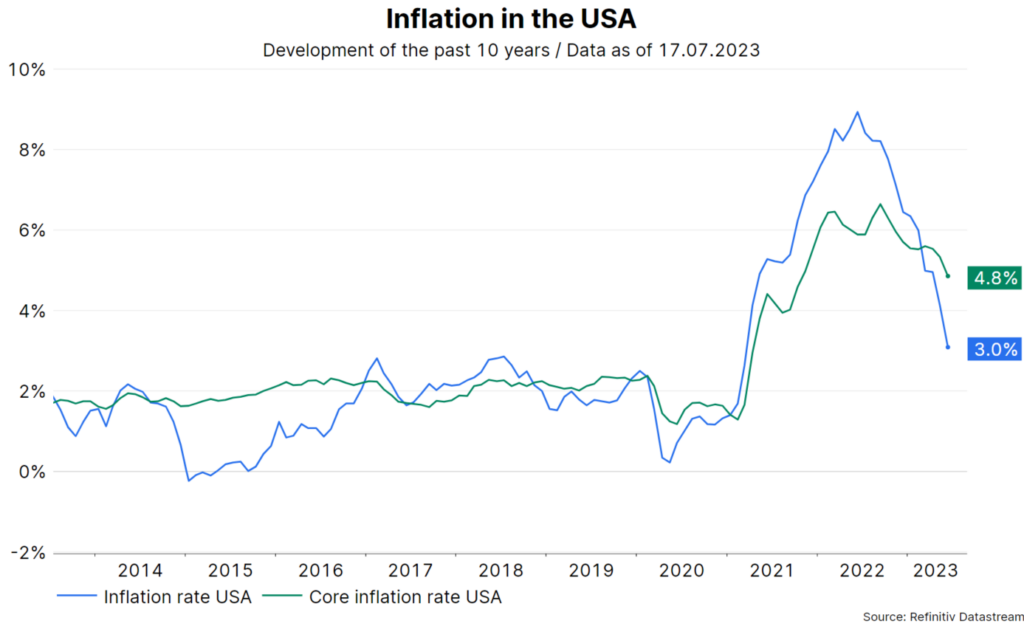Can price stability, i.e. inflation of 2%, be achieved without a recession? The historical relationships between economic indicators answer this question in the negative. But the further decline in US inflation for the month of June has raised expectations for this favorable scenario.
Inflation falls faster than expected
The report on consumer price inflation in the US for the month of June has pointed to a larger-than-expected decline across the board. The overall figure rose 3.0% on an annual basis, down from 4.0% the previous month. The core rate, i.e. excluding the volatile components food and energy, rose 4.8% on an annual basis, which was also significantly below the previous month’s value of 5.3%.

Source: Refinitiv Datastream; Note: Past performance is not a reliable indicator for future performance.
Other indicators also point to a downward trend in price increases. he components with a high persistence of inflation (sticky CPI) increased by 0.2% in the month of June (high: 0.7% in September 2022). The measure preferred by Federal Reserve Chairman Powell, inflation in the services sector excluding food, energy and rents, was actually unchanged month-on-month in June (high: 0.8% in April 2022).
…on a broad basis
In addition, other inflation reports were also favorable. Producer prices showed an increase in the core rate of only 2.4% on an annual basis and US import prices continued to decline to -6.1% year-on-year.
According to the University of Michigan’s flash estimate, consumer inflation expectations for the coming twelve months rose slightly in July (to 3.4% from 3.3%), but the trend is clearly pointing downward. Moreover, a figure of 2.9% would already be a level consistent with 2% inflation. Of course, this is only if the historical relationship between inflation expectations and actual inflation continues to hold.
Furthermore, a report on wage growth by the Federal Reserve Bank of Atlanta showed a further decline. The so-called Wage Growth Tracker fell to 5.6% year-over-year in June (high: 6.7% in June 2022). That level is not yet consistent with 2% consumer price inflation. That’s because productivity growth is low. But the trend in wage inflation is clearly pointing down.
Positive real wages
Classically, the development of wages lags behind that of inflation. Wage growth is thus inconsistent with the definition of price stability, but falling inflation usually means falling wage inflation with a time lag. In the meantime, rising inflation-adjusted wages support personal income and thus private consumption. Indeed, real average hourly wages rose 1.2% year over year in June. This measure had been negative since the second quarter of 2021.
Recession probability down
The falling inflation trend reduces the probability of recession because there is less pressure on the central bank to step up its restrictive policy even further. However, the favorable inflation trend can quickly be cancelled out by future poor inflation reports. Moreover, it is unclear at which level inflation will settle and whether inflation uncertainty or inflation volatility will then remain high or fall.
A key interest rate hike of 0.25 percentage point at the Fed’s upcoming rate meeting remains very likely. It is also likely that the maintenance of a restrictive policy will be reaffirmed, meaning that indications of key interest rate cuts are not to be expected. However, it is also likely that the central bank will signal a longer pause in the rate hike cycle in order to better assess the effects of previous key rate hikes.
Conclusion: Favorable environment for financial markets
The inflation reports in the USA are clearly favorable for the financial markets. First, the main enemy of bonds, high inflation, looks less threatening. Second, the same is true for the main enemy of equities, a recession.
However, history urges caution. In the past, a central bank-induced decline in inflation has often been accompanied by a recession. Therefore, caution is still warranted. A flawless inflation decline (without a recession) would be too good to be true.
For a glossary of technical terms, please visit this link: Fund Glossary | Erste Asset Management
Legal note:
Prognoses are no reliable indicator for future performance.

